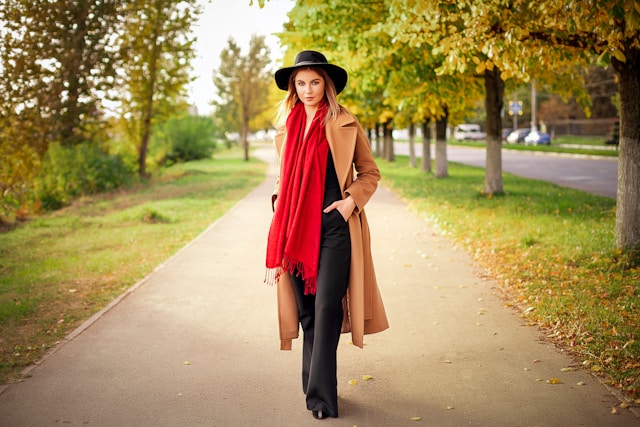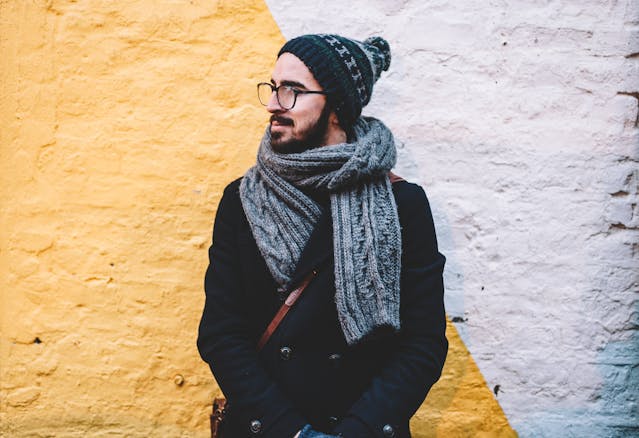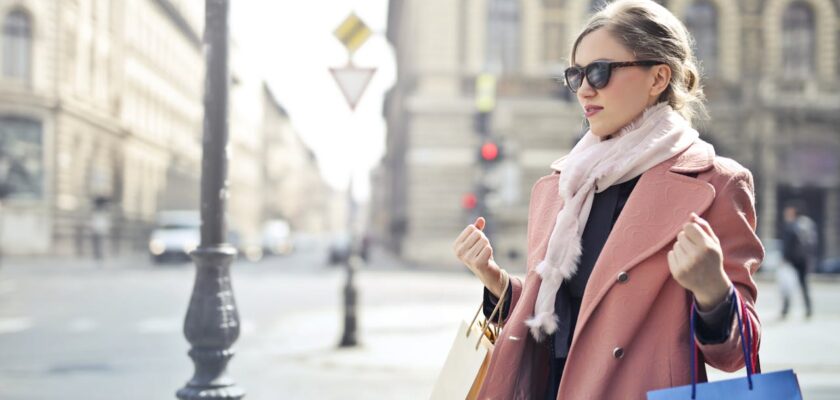French scarves are popular due to their stylish look and natural materials, especially if they are hand-made. French scarf is thought to be the best accessory to supplement your image.
However, the wrong scarf can ruin any, even the most well-designed look. And it’s not just about beautiful/ugly, there are also the proportions of the silhouette. No one wants to turn into a royal penguin, who has a huge apron instead of a neck, broadening the shoulders.
You can’t save the wrong look with a scarf
A well-designed look can only be created through clothing. If the look is poorly composed in terms of combining things and palette, a scarf will not save it, but will only make the situation worse. “I’ll put on a cheerful scarf, and you’ll see, everything will look better” – this does NOT work. A scarf is an accessory. It can complement, make a beautiful accent, warm up, in the end, an initially well-designed look, which looks great without a scarf.
Don’t tie unrestrained nautical knots around your neck
Firstly, it immediately gives stylistically negative references to outdated image formats, so you will visually add 150 years to your image to the existing ones. YouTube videos from the series: “How to tie a scarf with three knots, and then make a braid out of it” are morally obsolete. Also, we leave roses, braids and other joys of weaving and tying in the past.

Photo by Andrey Zvyagintsev on Unsplash
Why do you need a scarf for an image that is good without a scarf
Remember, in order to wear a French scarf beautifully, the original image must be correct and harmonious even without a scarf. But why then do you need a scarf in such an image?
To decorate the image
For example, you have a good basic combination of a beige jumper and white jeans. It is excellent, the things sit well on your figure, go well with each other. But you want to make the image a little more complex than geometric, add something interesting. Take a long ribbed scarf that matches the jumper and throw it over your shoulder. That’s it. This will immediately make the look more interesting, give it a more complex silhouette, but won’t ruin the proportions.
To enhance the proportions
You have a voluminous bottom and a narrow top. Put on dark trousers underneath to visually narrow it, to draw attention away from the bottom. And on top, the same jumper, much lighter, with volume in the sleeves to balance the bottom and top. And at this stage, everything should already be fine in terms of proportions. But you decided to go further and put on a scarf half a tone lighter with the jumper, thereby slightly completing the top.
What is better to choose for every day
Don’t be guided by emotions, but by common sense. An everyday scarf should not be “cheerful”, it should be universal, comfortable, go with most things in the wardrobe and serve well, without stretching or coming out of threads and snags.
Dense knitting is ideal
It does not matter whether it is thin or thick, the main thing is without large holes. Rare knitting very quickly fails even with good quality of an expensive thing, stretches, turns into a semblance of a rag.
Take a color that goes with most shades of your wardrobe. Many people think: “I’ll take a cheerful scarf, make interesting images with a contrasting color of the scarf, I will be stylish.” In practice, the images come out ridiculous, the scarf does not go with either outerwear or most things.
Take either a neutral-universal palette, or decide in advance for yourself that a new bright red scarf for my red / black jumper, and that’s it.

Photo by Clem Onojeghuo on Pexels
An adequate print is very important
It is best to take either soft or hard geometry. Birds, butterflies, zigzags can still be placed normally on a thin scarf with a very big stretch (and even then, we do not advise anyone to wear these infantile prints), but on a thick scarf this will not work.
Tie a scarf not for warmth, but for decorative purposes, as it should be
Here, too, you do not need to invent anything: casually wrap the scarf around the neck, or simply throw it over the neck, leaving the ends hanging vertically along the body. In this case, the number of turns will depend on the texture and size of the accessory.Photo by Andrea Piacquadio on Pexels
The denser and more massive the material, the more you need to avoid twisting and “creasing”. Try to lay such a scarf out loosely. The fabric of thin and light scarves naturally twists and lays out, it looks great. But with voluminous scarves it is better not to allow this.
